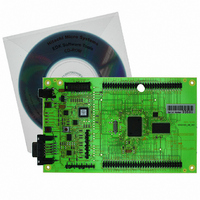EDK2398 Renesas Electronics America, EDK2398 Datasheet - Page 11

EDK2398
Manufacturer Part Number
EDK2398
Description
DEV EVALUATION KIT H8S/2398
Manufacturer
Renesas Electronics America
Series
H8®r
Type
MCUr
Specifications of EDK2398
Contents
2G (Second-generation) Evaluation Board, HEW debugger support, Cable and CD-ROM
For Use With/related Products
H8S/2398
Lead Free Status / RoHS Status
Contains lead / RoHS non-compliant
5.4.
The programming serial port is connected to the RS232 connector by default. This allows direct programming of the EDK
using the supplied software tools. A secondary serial port is available on the microcontroller and can be connected to the
RS232 connector by changing some board option links. The additional port option allows the user to write messages or
connect to other devices via the serial port while programming support is provided by the Flash programming header.
The following surface mount, zero-ohm link settings are fitted by default and connect the RS232 header to the programming
serial port of the microcontroller.
To enable the use of this alternate port the user must change the settings to those in the following table.
The user may implement a handshaking protocol on the EDK. This is not supported with the software tools supplied. To
support this option two spare port pins have been allocated on the microcontroller. Using these port pins the CTS and RTS
lines of the host serial interface can be controlled.
The user may also control the operation of the board via the same handshaking lines. This is not supported with the software
tools supplied but may be written by the user. Using the CTS line the user may simulate pressing the boot button, see
section:5.7. This will cause the EDK to swap into and out of Boot mode on each low-level activation of CTS. Feedback of the
current mode is provided on the RTS line. A high level indicates boot mode and a low level indicates user mode.
The following settings are made by default, and ensure that there are no conflicts on unnecessary microcontroller pins.
* See section 5.7
Note:
5.5. F
The Flash Programming header is used with the Hitachi Flash Debug Board (FDB). The FDB is a USB based programming
tool for control and programming of Hitachi microcontrollers, available separately from Hitachi. This header provides direct
access for the FDB to control the EDK microcontroller.
Caution: Do not operate the board with the user mode jumpers removed and the FDB disconnected as the
microcontroller mode pins will float to an indeterminate state. This may damage the microcontroller device.
•
S
LASH
These setting pairs are exclusive:
If CR12 and CR7 are fitted; CR16 and CR13 must not be fitted.
If CR16 and CR13 are fitted; CR12 and CR7 must not be fitted.
To utilise this header the user must disable the RX232 signal from the RS232 transceiver.
Jumper link CJ4-A is provided for this purpose. Please refer to section 5.3.
ERIAL
CR12
CR7
CR16
CR13
P
Zero-ohm
P
CR20
CR23
CR19
CR22
CR20
CR23
CR19
CR22
Link ID
ROGRAMMING
ORT
Zero-ohm
Zero-ohm
Link ID
Link ID
S
ELECTION
Not Fitted
Not Fitted
Not Fitted
Not Fitted
Default
Fitted
Fitted
Not Fitted
Not Fitted
Not Fitted
Not Fitted
Fitted
Fitted
H
Default
Default
EADER
Mode State out from EDK
Change Mode request to EDK
Alternate RTS232 – Ready to send – from EDK
Alternate CTS232 – Clear to send – to EDK
T
T
Transmit data from EDK
Receive data to EDK
Alternate Transmit data from EDK
Alternate Receive data to EDK
Transmit data from EDK
Receive data to EDK
Alternate Transmit data from EDK
Alternate Receive data to EDK
ABLE
ABLE
T
ABLE
5-4: O
5-5: O
5-3: O
PTION
PTION
PTION
L
Function
L
INKS
INKS
Function
Function
L
INKS
– A
– S
– D
LTERNATE
ERIAL
EFAULT
P
ORT
S
S
ERIAL
ETTINGS
C
ONTROL
P
ORT
N/A (From CPLD*)
N/A (From CPLD*)
P65
P64
P31
P33
P30
P32
P31
P33
P30
P32
Microcontroller
Microcontroller
Microcontroller
Port Pin
Port Pin
Port Pin
11




















